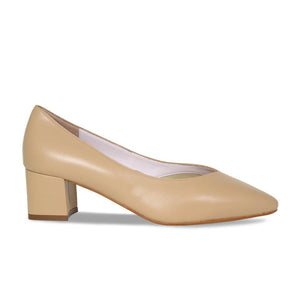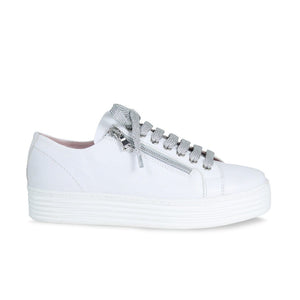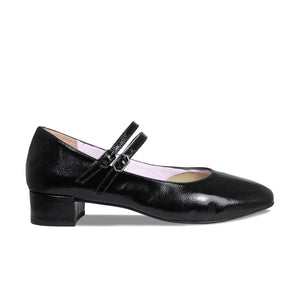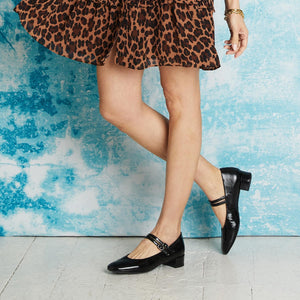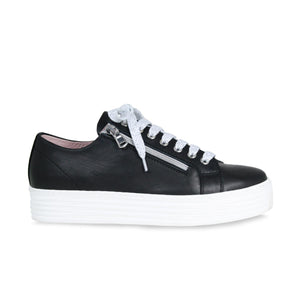What is Sciatica?

Have you recently been diagnosed with sciatica? If you’re struggling with it now, you’re certainly not alone. This painful yet common condition affects around 5-10% of people who experience lower back pain. In fact, millions of individuals in the UK suffer from it, making it one of the top reasons for GP visits and workplace absences. Not something to be taken lightly!
Sciatica refers to pain that radiates along the path of the sciatic nerve, which runs from your lower back, through your buttocks, and down each leg. When this nerve becomes inflamed, it can result in severe pain and discomfort. We are going to show you some of the best shoes for sciatica, shoes for sciatica relief and the best sneakers for sciatica. But first, let's look at what causes this condition?
What causes Sciatica?
Typically, sciatica nerve pain arises from the compression or irritation of the sciatic nerve, which is often due to a herniated or slipped disc. This occurs when one of the discs in your spine presses on the nerve, leading to “radiating” pain, often from the lower back down through the leg.
However, there are other causes of sciatica. One common cause is spinal stenosis, the narrowing of the spinal canal. This narrowing can place pressure on the nerves, including the sciatic nerve, leading to symptoms such as pain, numbness, and weakness. According to the NHS, 11% of the population suffers from spinal stenosis, which predominantly affects older adults – ouch!
Another condition, spondylolisthesis, also contributes to sciatica. This occurs when one of the vertebrae in the spine slips out of place, often forward or backward, compressing nearby nerves, including the sciatic nerve. Spondylolisthesis is commonly caused by degenerative changes in the spine due to ageing, but it can also result from trauma, such as sports injuries or accidents.
Other potential causes include:
-
Piriformis syndrome, where the piriformis muscle in the buttocks irritates the sciatic nerve
-
Trauma or injury to the pelvis or spine
-
Tumours or infections near the spine, although these are rare causes
While sciatica pain can be quite severe, cases caused by a herniated disc often improve with treatment, typically within a few weeks to months. Treatments can range from physical therapy and anti-inflammatory medications to lifestyle changes such as improving posture. However, for individuals experiencing severe symptoms, surgery may be necessary to relieve pressure on the nerve and prevent further complications.

Pixie: White Leather & Denim Suede - Best Sneakers for Sciatica
SHOP NOW
What are the symptoms of nerve pain & Sciatica?
Many people experience various symptoms of nerve pain when dealing with sciatica. The most common symptom is a sharp, burning pain that radiates along the sciatic nerve, typically from the lower back, through the buttocks, and down the leg.
Some individuals also report numbness or tingling in the leg or foot, and the severity of the pain is often related to factors like the degree of nerve compression, posture, movement, and how long the nerve has been compressed.
Sciatica nerve pain is often described as radiating or shooting, and as the condition progresses, many people experience muscle weakness in the affected leg or foot, making it difficult to stand, walk, or even sit for prolonged periods. Some report that the pain feels like a jolt or electric shock, particularly when making sudden movements such as coughing, sneezing, or bending forward – even a simple "bless you!" moment can cause discomfort.
In severe cases, loss of reflexes or difficulty controlling bladder or bowel functions may occur, which can be signs of cauda equina syndrome, a serious condition requiring immediate medical attention.

Layton: Black Leather - Best Shoes for Sciatica
SHOP NOW
What are the best shoes for Sciatica?
When it comes to choosing the best shoes for sciatica, it’s important to find the perfect pair that can reduce stress on your joints. We’ve broken down the top eight factors to consider when choosing sciatica shoes. Luckily for you, Sole Bliss’ collection of stylish and oh-so-comfortable shoes ticks all the boxes, leaving you with the tough decision of whether to buy just one pair or two!
Cushioned footbed and sole
A blissfully cushioned footbed and sole is essential when choosing a pair of shoes for sciatica relief. With Sole Bliss, our shoes feature three distinct layers of high-quality, antibacterial memory foam, providing a luxurious custom-cushioning system.
The top layer offers ultimate softness and cushioning under your entire foot. Underneath, the second layer provides custom support, contouring your foot to distribute body weight evenly and relieve stress on your lower back and legs. And the third layer? More on that later… we'll explain why we make the best shoes for sciatica.

Treasure: Tobacco Suede - Best Shoes for Sciatica Nerve Pain
SHOP NOW
Heel height/elevation
If you’re suffering from sciatica, towering stilettos are probably not at the top of your shopping list. However, a moderate heel height, typically between 1-2 inches, can work well for you by keeping the spine aligned and reducing strain on the sciatic nerve.
We offer a great selection of kitten heels and low-block heeled shoes for sciatica if you want to go a bit smarter than sneakers or loafers. Check out our heeled shoes for sciatica here.
Arch support
Supporting your arches is crucial in shoes for sciatica as it helps distribute pressure across the feet and prevents excessive inward foot roll. When your arches are well-supported, the pressure on your sciatic nerve is relieved simply by maintaining proper posture and alignment.
With Sole Bliss closed-back heels, we include a small memory foam pillow designed to hold your foot in the correct position and counter pronation. We don’t call it superior arch support for nothing!
Stability
If you’re living with sciatica, maintaining a balanced and stable posture is essential for reducing nerve compression. Shoes that offer excellent stability help minimize imbalance and reduce additional strain on the lower back.
Our Miracle Sneakers, with their ultra-cushioned, anatomically contoured footbed, are a must-have in every woman’s wardrobe. They protect your feet and support stability with every step, making them the perfect shoes for sciatica relief.

Drama: White Leather - Good Shoes for Sciatica
SHOP NOW
Correct size fit
It goes without saying that ensuring you get the correct shoe size is essential, as ill-fitting shoes can lead to instability and worsen any pain you have. You can check out our handy size chart
Shock Absorption
Shoes with shock-absorbing materials are excellent for cushioning your feet when walking on hard surfaces. Sudden impacts and jolts to the feet can aggravate sciatica pain, making shock absorption a must.
Remember we mentioned the third layer of our award-winning cushioning technology? This bottom layer is specially designed for high-performance shock absorption, offering enhanced protection for the ball of your foot, keeping you moving comfortably throughout the day.

Montana: Tan Suede - Shoes for Sciatica
SHOP NOW
Durability
Ensuring your sciatica shoes are durable is essential, as they not only last longer but also maintain the vital cushioning and support needed to prevent further strain on your sciatic nerve. A high-quality, durable shoe will continue to provide the stability and shock absorption necessary to reduce discomfort, so you can rely on them for long-term comfort and protection.
Flexibility
Finally, flexibility is key for shoes for sciatica. With flexible soles, your feet will have a better chance of maintaining your body’s natural alignment, ensuring the foot can bend and move without worsening sciatica symptoms.

Keira: Black Leather - Shoes For Back Pain
SHOP NOW
What worsens Sciatica?
We’ve touched on what can make your sciatica symptoms worse, but let’s delve deeper into the common causes that can exacerbate the condition.
Wearing the wrong shoes
To recap, wearing the wrong shoes can cause a multitude of problems for sciatica sufferers. Things to look out for include shoes that lack proper support, cushioning, stability, and flexibility. However, it’s also important to remember that your shoes should be flat or have a sensible heel to aid shock absorption.
Not managing your stress
Stress can be a major factor in worsening sciatica symptoms. Tension can tighten the muscles, especially in the back and lower body, while chronic stress can cause inflammation and worsen pain perception. Incorporating mindfulness techniques or gentle yoga can help alleviate these symptoms.

Chloe: Chestnut Patent - Shoes for Sciatica
SHOP NOW
Diet choices
A poor diet, especially one high in inflammatory foods such as processed sugars and fats, can cause inflammation throughout the body. When doing your food shop, make sure to stock up on delicious, vitamin-boosting superfoods such as leafy greens, omega-3-rich fish, and nuts, which are all considered beneficial for improving nerve health.
Sitting down for too long
If you are suffering from a bad back, you may want to sit down for extended periods. However, prolonged sitting – especially in positions that strain the lower back – can compress the sciatic nerve or worsen nerve irritation. Make sure to take regular breaks and, if possible, stand and walk around to relieve pressure on the sciatic nerve.
Not varying your exercise
While sports-related injuries can cause sciatica, over-exercising can worsen its symptoms. When planning your workout routine, make sure to incorporate a mix of strengthening, flexibility, and low-impact exercises to keep the muscles around the sciatic nerve strong and limber.

Luna: Navy & Cream Leather - Shoes for Sciatica Relief
SHOP NOW
FAQ
Can shoes affect sciatica?
Shoes can have a significant impact on sciatica symptoms. Wearing the wrong pair can increase strain on the lower back, worsening nerve compression and discomfort. The right shoes for sciatica, however, can alleviate pressure by providing proper support, cushioning, and stability, helping to reduce sciatica flare-ups. Our range of Sole Bliss shoes is designed with these features in mind, offering a blend of style and functionality to help manage sciatica more comfortably.
Can high heels help sciatica nerve pain?
Although we wouldn’t recommend heels for sciatica, a moderate heel – around 1-2 inches – can help keep the spine aligned. However, it is important to find low-heeled shoes that provide adequate support.

Valencia: Taupe Suede & Snake - Sciatica Shoes
SHOP NOW
Can flat shoes cause sciatica?
It’s understandable to think that flat shoes can help with sciatica, but choosing pairs with little to no support or cushioning can fail to distribute body weight evenly, leading to poor posture and ultimately worsening sciatica symptoms. At Sole Bliss, all of our flats come with our award-winning comfort technology to ensure you avoid these common issues. Discover our range of comfortable flats here.
Can sciatica occur down both legs?
Usually, sciatica only occurs down one leg; however, it is possible for it to affect both. This is a condition called bilateral sciatica, which can occur if both sides of the sciatic nerve are compressed. It can arise in extreme conditions such as a large, herniated disc, spinal stenosis, or spondylolisthesis. If you experience this condition, we recommend seeking professional help as it may require medical attention.

India: Pale Taupe Patent - Best Shoes for Sciatica Nerve Pain
SHOP NOW
To view our full collection of Sole Bliss shoes, please visit: us.solebliss.com/collections/all














